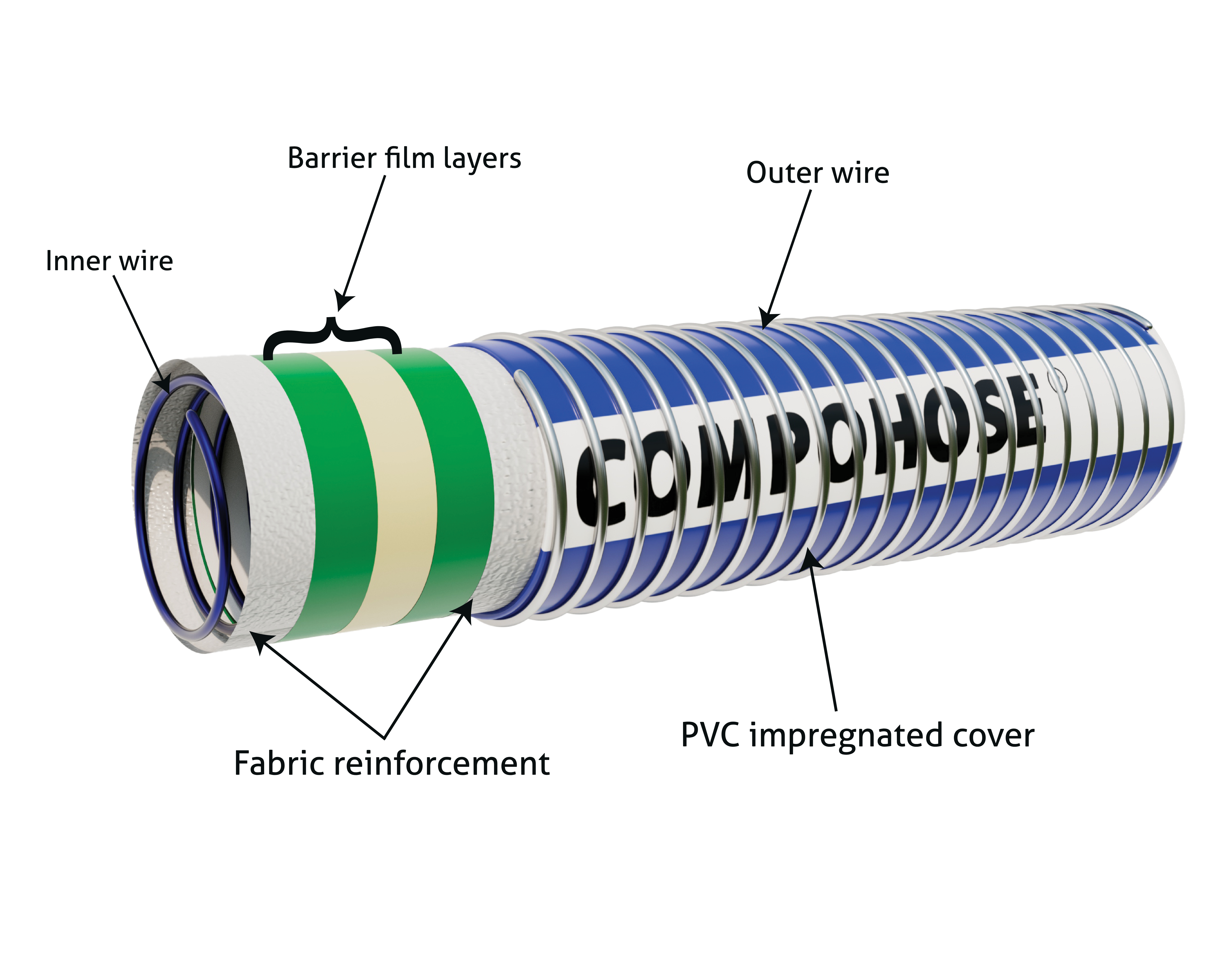Multichem: Standard Duty

Multichem Standard Duty Composite Hoses have been meticulously crafted to excel in the comprehensive management of a diverse array of chemical compounds. These hoses present a host of attributes that collectively guarantee both the safety and effectiveness of substance handling. Possessing a remarkable degree of flexibility and characterized by their lightweight composition, Multichem composite hoses stand as a versatile solution tailored for the proficient navigation of an extensive spectrum of inorganic and organic fluids. This includes the secure and efficient management of various types of chemicals found in non-corrosive environments.
Compliance : Multichem hoses are manufactured in accordance to EN 13765 / 2018 Type 2


Construction
- Hose Type - PPG, SPG, PPS, SPS, PSPS
- Inner wire - Polypropylene Coated Galvanised Steel/ Stainless Steel 304,316
- Inner Lining -Polypropylene liner with heavy duty polypropylene carcass for maximum chemical resistance
- Outer wire -Galvanised Steel/Stainless Steel 304, 316
- Cover - Abrasion-resistant PVC impregnated fabric
- End fitting - As per client requirements, externally crimped and swaged
Features
- Tough PVC outer cover resists dragging, wearing, abrasion, UV and ozone resistance ensures maximum durability and safety.
- Light Weight & Highly Flexible
- Superior Electrical Continuity
- Suitable for 0.9 Bar Vacuum rating.
- Working Pressure: 10 Bar (150 PSI) (Standard Duty)
- Safety factor 4:1 as per EN 13765 / 2018 (can be achieved higher if required)
- Temperature Range for this hose is -30° C to +100° C (-22° F to +212° F)
Applications
Petrochemicals Industry: Multi Chem Standard Duty Composite Hoses are ideal for transferring high intensity chemicals and alkalis commonly used in the petrochemical industry. They provide a safe and efficient way to transport chemicals within a petrochemical facility.
Processing Plants: These hoses are valuable in processing plants where a diverse range of chemicals such as amines, ketones, and chlorinated hydrocarbons are used in various production processes. They ensure the secure and reliable transfer of these chemicals.
Shipping Industries: The shipping industry often deals with transporting chemicals in bulk. Multi Chem hoses are a valuable asset in this context, allowing for the safe loading and unloading of chemicals on ships, as well as their transfer between vessels and onshore storage facilities.
Tank Storage Chemical Transfer: Storage tanks are commonly used for holding bulk quantities of chemicals in industrial facilities. When it comes to transferring chemicals into or out of these tanks, the Multichem hoses prove to be essential. The hoses are designed to withstand the corrosive nature of many chemicals, preventing any leaks or chemical reactions that could compromise the safety and integrity of the stored substances.
Rail Wagon Loading and Unloading of Chemicals: Rail transportation is a common method for moving chemicals between different locations. Loading and unloading chemicals from rail wagons require specialized equipment to ensure the safe transfer of materials. Multichem hoses are used in this application to connect the railcar’s storage compartments to the facility’s storage tanks or processing units. These hoses provide a flexible and durable conduit for the chemicals, allowing for efficient and secure transfer operations.
Specification Table :
| CODE | SIZE | MEAN OD | MAX W.P | MIN BURST | BEND RADIUS | WEIGHT (KG) | MAX LENGTH | |||||||
| NAME | MM | INCH | MM | BAR | PSI | BAR | PSI | MM | INCH | GG & SG | MT | FT | ||
| C01PG25 | 25 | 1” | 37 | 10 | 150 | 40 | 600 | 125 | 5 | 1.10 | 30 | 100 | ||
| C01PG38 | 38 | 1.5” | 50 | 10 | 150 | 40 | 600 | 150 | 6 | 1.43 | 30 | 100 | ||
| C01PG50 | 50 | 2” | 65 | 10 | 150 | 40 | 600 | 200 | 8 | 1.60 | 30 | 100 | ||
| C01PG65 | 65 | 2.5” | 76 | 10 | 150 | 40 | 600 | 200 | 8 | 2.10 | 30 | 100 | ||
| C01PG75 | 75 | 3” | 89 | 10 | 150 | 40 | 600 | 300 | 12 | 3.20 | 30 | 100 | ||
| C01PG100 | 100 | 4” | 119 | 10 | 150 | 40 | 600 | 400 | 16 | 5.10 | 30 | 100 | ||
| C01PG150 | 150 | 6” | 178 | 10 | 150 | 40 | 600 | 575 | 23 | 11.00 | 30 | 100 | ||
| C01PG200 | 200 | 8” | 231 | 10 | 150 | 40 | 600 | 800 | 32 | 16.40 | 30 | 100 | ||
*Higher burst pressure can be achieved on special request
Safety Standards
Rigorous Safety Testing
COMPOHOSE assemblies undergo comprehensive testing, conducted at 1.5 times the rated Working Pressure (W.P). This stringent testing adheres to the EN 13765 standard, ensuring a paramount level of safety and reliability.
Provision of Manufacturer's Test Certificate
With each supply of COMPOHOSE composite hose assemblies, a Manufacturer's Test Certificate is included. This certificate serves as a confirmation of the product's quality and compliance with safety standards, providing added assurance to users.
Clear Burst Pressure Specification
The burst pressure of the composite hose is explicitly indicated for ambient temperature conditions. This vital information enhances safety awareness and empowers users to operate within secure pressure limits.
Effective Electrical Continuity
The composite hose's electrical continuity is assured through the integration of two bonded wires connected to the end fitting. This innovative design promotes the dissipation of accumulated electrical charges, mitigating the risk of static flashes and associated hazards.



